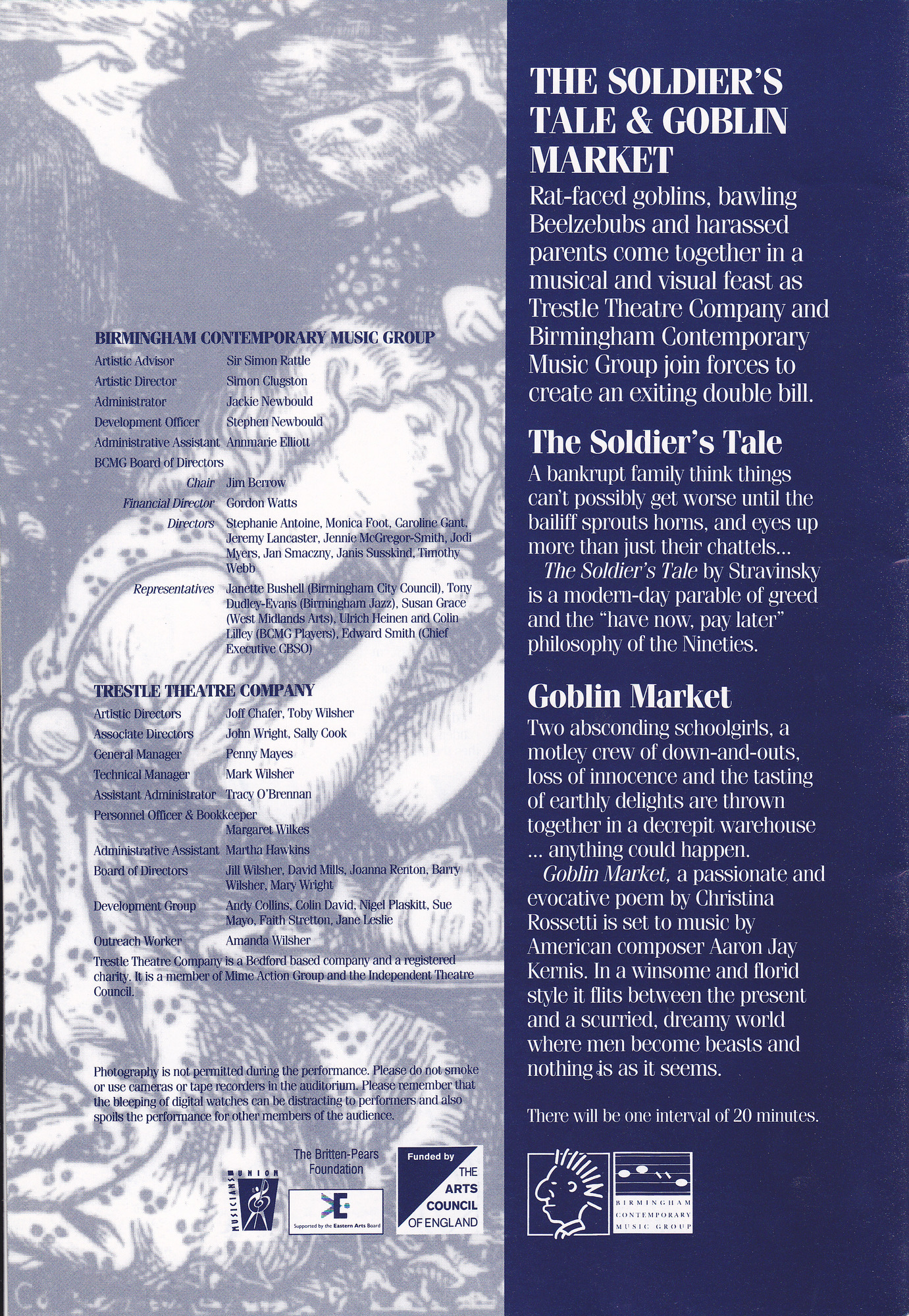Composition History
a commissioned work
As stated in the published score, Goblin Market was co-commissioned by the Birmingham Contemporary Music Group (BCMG) and the St. Paul Chamber Orchestra with funds provided in part by the Meet the Composer New Residencies Program, the Arts Council of England and investors as part of the BCMG’s Sound Investment Scheme.
Biographer Leta E. Miller writes that Kernis composed Goblin Market in a concentrated effort in the months leading up to its 12 January 1995 premiere: "Indeed, he managed to meet the premiere deadline for that work, but not by much. As he frantically completed various sections of Goblin Market, he fed them to Schirmer, which had them typeset and sent on to the Birmingham Contemporary Music Group, but the performers did not receive the final typeset score until January 6, 1995, six days before the first performance" (Miller, p. 97).
Kernis’s comments
Kernis recorded an interview discussing Goblin Market and the recording of this composition, which was conducted by Rebecca Miller, performed by The New Professionals, narrated by Mary King, and released as a commercial cd in 2011 under the Signum Classics label. [link] In this interview, Kernis describes how he came to adapt Rossetti’s famous poem: “I found the text for Goblin Market on one of my usual bookstore rambles looking for poetry, and it was sitting on my shelf for quite a while. I had sort of tucked it away. I knew it was an amazing work . . . and I love food, so that was the first thing that drew me to it—all the very specific mention of fruit, the sensuality of fruit, the colour, and the change of mood, the great reach of the poem” (Alexander). Kernis is not sure what reminded him to return to “Goblin Market” when he was approached by the Birmingham Contemporary Music Group in the mid-1990s to compose a new work for them, but Kernis speculates that the prompt might have come from a visit to a Birmingham museum and seeing Pre-Raphaelite art there. Whatever sparked his interest, something reminded him to go back to this text. The work took shape originally in the context of the Birmingham Contemporary Music Group’s interest in collaborating with a mime company, and the work premiered as a collaboration with the Trestle Theatre Company. Kernis says that he was “thrilled that it was going to be staged” (Alexander), but that he always intended that the composition be presented as a concert work as well.
Kernis himself sees his composition as “steeped in the Romantic music drama and really the kind of approach to musical development that comes from Wagner, a little bit before Wagner, but especially embodied in his work and composers that followed him” (Alexander). He goes on to say that “there are small motives that appear in particular instruments and are developed in various ways throughout the work. Sometimes they are motives that relate to the psychology of the moment and of the development of the text. At other times, they are very specific to characters in the music. So, what I chose to do is to give specific characters in the text to certain solo instruments: the sister Laura is the viola, and her sister Lizzie is portrayed by the violin, and the goblin creatures for the most part tend to live in the woodwinds and a little bit in the brass” (Alexander).
modern references
Kernis attributed the composition's initial impulse to “the tangled roots of desire, seduction and the loss of innocence at the heart of the text, which connects to our own end-of-century lack of innocence” (undated note from Kernis's personal archive, qtd in Miller, p. 78). Kernis also comments on how details of Rossetti’s Victorian circumstances—her passionate temperament, the religious and social codes that repressed and restricted passionate impulses, her two failed romances, and important bonds among women—informed his composing. Kernis was also very attuned to modern resonances, specifically, to the AIDS epidemic: “Certainly the parallels between Laura’s poisoning in the text and our AIDs [sic] epidemic remained most palpable for me” (Kernis, “A Note on Goblin Market”).
Acknowledgement:
I would like to express my gratitude to Dr. Lorraine Janzen Kooistra (Ryerson University) for her scholarly support and for sharing with me her collection of primary materials related to stage adaptations of “Goblin Market.”
Sources:
Miller, Leta E. Aaron Jay Kernis. Champaign, IL, U of Illinois P, 2014.
Kernis, Aaron Jay. “A Note on Goblin Market,” double-bill program for The Soldier’s Tale and Goblin Market, 12-22 January 1995.
“Goblin Market: Aaron Jay Kernis.” YouTube, uploaded by Signum Records, 21 Jan. 2011, www.youtube.com/watch?v=fPMaOk_BnAE.


